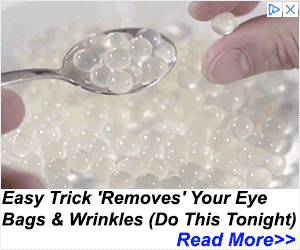The natural skin care industry is one of the fastest-growing markets in beauty.
There are plenty of reasons to use natural skin care instead of traditional products, like avoiding potentially harmful synthetic chemicals. Plus, it’s an eco-friendly option.
What is natural skin care?
The term “natural skin care” can mean different things. The “natural” label isn’t regulated across the industry. This means each company can choose what “natural” means for themselves.
BREAKING: 72-Year Old Grandma's Anti-Aging Discovery Sweeps The Nation
“There’s a lot of debate in the industry on what’s considered ‘natural’ and what’s not,” says licensed esthetician and beauty blog author Dana Murray.
“Often, natural ingredients can be inconsistent in makeup, so it’s hard to measure effectiveness and potency. [As well, some] natural ingredients, like essential oils, can cause irritation to the skin,” she says.
Benefits of natural skin care
According to a 2015 study, botanical products can be a rich source of:
- vitamins
- antioxidants
- essential oils
- hydrocolloids
- proteins
- terpenoids
- bioactive compounds
According to the study, plant extracts can be a safe and cost-effective alternative to synthetics.
For oily skin
A natural skin care routine for oily skin may help reduce oiliness without the use of expensive skin care regimens or prescription drugs.
There are several methods of using natural skin care and home remedies for oily skin.
For dry skin
There isn’t much that’s more frustrating than itchy skin.
A natural skin care routine for dry skin may help reduce the effects of heat, hot showers, arid climates, and harsh soaps — all things that can trigger dry skin.
For combination skin
Caring for combination skin isn’t always the easiest, but it’s still possible to find a natural skin care routine that simultaneously combats dry patches and shine.
Products that include harsh ingredients, such as fragrance, can irritate both oily and dry skin. Using natural skin care products may be a step in the right direction.
For acne-prone skin
A natural skin care routine for acne has many benefits, like saving money by avoiding expensive acne solutions. It can also help prevent undesirable side effects, such as dryness, redness, and irritation.
There are lots of natural solutions and home remedies for acne to meet your needs.
For sensitive skin
A natural skin care routine for sensitive skin may help rebuild a healthy skin barrier by avoiding products with irritating ingredients.
A 2018 study examined the risk of skin sensitivity associated with products containing fragrances. Products that are more likely to be worn for a long period, like moisturizers, are more likely to cause skin issues.
For Black skin
Black skin contains more melanin than lighter skin. A few conditions that people with Black skin may experience more often include:
- acne
- hyperpigmentation
- contact dermatitis
- eczema
- seborrheic dermatitis
The natural skin routines linked above can assist with a number of these skin conditions.
Terms to know
With no strict definitions, you’re largely on your own to research which products are “natural” to you. Luckily, this article can help.
What is the product derived from?
This is the first question to ask yourself.
In other words, what’s in it, and where does it come from? Is it a natural source, like plants, animals, minerals, and marine sources? Or is it derived from petrochemicals?
- Naturally-occurring. This means that ingredients are used in their natural, unprocessed state. Examples of naturally-occurring ingredients include raw honey and crushed flowers.
- Nature-identical. This means that ingredients are produced in a lab and are chemically identical to those that occur in nature. An example is sorbic acid. Originally derived from rowan berries, sorbic acid is now commonly included as a nature-identical ingredient.
- Synthetic. This term sits on the far end of the spectrum and includes ingredients that were created and processed in a lab. An example of this is parabens, which are common beauty preservatives.
How is it processed?
Just because ingredients are derived naturally, it doesn’t mean they’re processed naturally.
Ingredients can be processed physically or chemically.
- Processed physically means the molecular composition or structure stays the same.
- Processed chemically means the molecular composition or structure changes.
Examples of naturally derived but physically processed ingredients include raw, unrefined oils and butters. These are processed through means like cold-pressing or filtration.
An example of a naturally derived but chemically processed ingredient would be castor wax. It’s a vegetable wax derived from the castor bean produced by adding hydrogen to pure castor oil, a process called hydrogenation.
Know your labels
There are various certifications and marketing words under the umbrella of “natural” products. Some are regulated and some aren’t.
Organic
Companies can have their products certified organic.
They can also label their products as organic to indicate that all the ingredients are derived from organic sources. This means the product itself may not be certified, but all the ingredients are certified organic.
Looking for a brand that’s USDA certified organic? Try 100% PURE. Their products are non-toxic, free of parabens and sulfates, vegan, and cruelty-free. And they offer eco-friendly packaging.
Green
This unregulated term refers to environmental impact and sustainability.
Green products are usually produced with intention of limiting environmental impact.
For example, a green product may contain raw materials that are harvested in a way to support the environment rather than harming it.
Juice Beauty is another USDA certified organic brand that’s free of parabens, sulfates, and artificial dyes. Environmentally, they source locally, use recycled packaging, and produce using solar and wind energy. They’re also vegan and cruelty-free.
Clean
This unregulated term describes products that typically focus on being non-toxic.
Vegan
These products are created without animal by-products.
For another organic, vegan, cruelty-free brand, try OSEA. They use hand-harvested ingredients and are free of GMOs and gluten.
Cruelty-free
It’s important to note that, while vegan products are almost always cruelty-free, cruelty-free products are not always vegan. An example would be an organic lip balm that contains beeswax.
Brands can claim these terms without being certified. But, if you want to ensure it, there are several organizations that certify vegan and cruelty-free products.
Fair-trade
This regulated descriptor focuses on sourcing, ensuring that ingredients are sourced ethically in terms of the planet, people, or environment.
Best natural skin care routine for 30s and beyond
During your 30s, hormone levels start to decrease, and the rate of collagen and elastin production goes down.
Still, everyone’s skin is different. What suits one person’s skin may not work for someone else.
As a general practice, the following routine works for most.
Morning
1. Cleansing
If all else fails, this first step should occur every morning and evening.
It’s best to look for a face wash that’s full of skin-nourishing vitamins, such as vitamin A, vitamin B2, vitamin B12, and vitamin E.
2. Exfoliating
Exfoliants shouldn’t be used daily. Instead, 1–3 times per week is enough to remove dead skin cells without causing irritation.
On the days when you aren’t exfoliating, simply use your cleanser by itself.
3. Toning
Toners are one of the most common steps left out of skin care. Toner can help tighten pores, eliminate impurities, and rebalance your skin.
The best options are clarifying toners that rebalance your pH.
A few natural examples include grape seed extract or peach extract.
Additionally, taking an oral version of grape seed extract (proanthocyanidin) has shown to improve chloasma (also known as melasma), which causes hyperpigmentation of the skin.
4. Moisturizing
Ceramides are key ingredients to look for in moisturizers.
To be specific, look for phytoceramides, which are plant-derived ceramides. These are waxy lipids found naturally in skin that hold in moisture.
Jojoba oil is another great moisturizing ingredient that boosts rejuvenation and protects against environmental stressors.
Serums are essentially next-level moisturizers. They deliver active ingredients deep into the dermal layers. Use a couple of drops of serum on your cheeks, chin, nose, and forehead.
5. Sun protection
SPF is recommended daily at any age.
Pro tip: Creams should be applied with the lightest fluids first. For example, serum, moisturizer, then SPF.
Nighttime
TRENDING: Big Pharma In Outrage Over This Breakthrough Natural Painkiller
1. Repeat the a.m. routine
Follow each step, but skip the sun protection.
2. Eye cream
The skin around your eyes is the most sensitive part of your face and one of the first areas to show signs of aging.
While eye creams often contain the same ingredients as regular moisturizer, they contain fewer aggravating chemicals.
Spend more time gently massaging your creams into your skin. This helps strengthen the muscles in your face and encourage collagen production.
3. Night moisturizer
Using a night cream can efficiently support your skin through the regeneration process.
Bonus steps
In addition to your daily routine, think about adding a few products for some extra TLC 1–2 times per week.
Detox mask
Once or twice per week, a lightweight mask that draws out impurities isn’t a bad idea.
Masks with charcoal or green tea leaves are really great at drawing out impurities and rejuvenating your skin, respectively.
Bakuchiol Serum
Retinol serum is often used in anti-aging routines for rejuvenation.
However, retinol is a synthetic ingredient. A plant-based alternative is bakuchiol, which was clinically proven to have anti-aging effects.
Homemade natural skin care
Clarifying oatmeal mask
This mask regulates the skin’s pH with apple cider vinegar while removing excess oil and buildup with ground oats.
Ingredients
- 3 tbsp. ground oats
- 1/4 tsp. apple cider
- 1/4 tbsp. lemon juice
- 1/2 tbsp. brown sugar
Directions
- Combine the ground oats and apple cider into a smooth paste.
- Add the lemon juice and brown sugar, stirring until even.
- Apply to freshly cleansed skin for 5–10 minutes.
- Rub in circular motions.
- Rinse off with warm water.
Tea leaves face toner
This toner isn’t only natural, but it also helps fight acne.
Ingredients
- 1 tsp. peppermint tea leaves
- 4 tsp. white tea leaves
- 1/2 cup boiled distilled water
- 2 drops of lavender oil
Directions
- Combine all ingredients in a French press.
- Let mixture steep for 10 minutes.
- Pour into a glass container to cool.
- Combine mixture with aloe vera until it fills a 4-oz. spray bottle.
- Spritz on face after cleansing, and store in the refrigerator.
Sugar face scrub
This homemade exfoliant nourishes skin while also sloughing off dead cells.
Ingredients
- 1/2 cup brown sugar
- 3 tbsp. honey
- 2 tbsp. oil of your choice
Directions
- Combine honey and brown sugar in a small bowl, and stir until it forms a thick paste.
- Add the oil and mix well.
- Spread the paste over clean skin.
- Leave on for 5–10 minute.
- Rinse with warm water.
BREAKING: 1 Cup of This Melts Belly and Arm Fat (Take Before Bed)
Safety
According to the American Academy of Dermatology Association, all-natural products, such as vitamins and herbal remedies, can interact with cancer treatment — specifically chemotherapy and radiation.
This is especially true for vitamin A, vitamin C, and St. John’s wort. Serious side effects can occur if used during cancer treatment. So it’s best to talk with your doctor before starting a new routine.
If a product is truly natural, a major drawback is short shelf life. Natural skin care products may only have a shelf life of 3–4 months.
Parabens (which are synthetic) keep products clean, contaminant-free, and usable for up to 2 years.
Takeaway
If you’re looking to go au naturel with your skin care routine, know there isn’t a one-size-fits-all approach.
Brands can call their cosmetics whatever they want under the “natural” umbrella, so be sure to do your research.
Remember to read the labels, and always do a patch test before fully diving into a new product.









